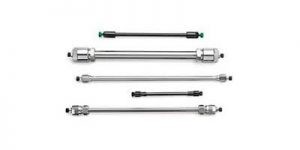What is HPLC?
High-Performance Liquid Chromatography (HPLC) is a method used nowadays to separate the mixture under high pressure. Usually, the sample with a suitable solvent (mobile phase) injected into an HPLC column filled with packed particles (stationary phase). When the mobile phase passes through the column, each component in the sample starts to separate and elute at different time.
How to Select Suitable HPLC Column for Your Work?
Many factors are affecting the column selection in HPLC, including:
- Types of HPLC Columns
- Length and Internal Diameter
- Bead Size
- Pore Size
Here, we’ll explain in more details on how each factor affect your HPLC column selection.
Types of HPLC Columns
There are many types of HPLC columns in the market, e.g. Merck. A few of the most commonly used types are Normal-Phase HPLC Columns, Reverse-Phase HPLC Columns, Ion-Exchange HPLC Columns, Size Exclusion HPLC Columns, Affinity HPLC Columns, etc[1,2]. These HPLC columns separate the analytes based on polarity, pore size, affinity and ion charges.
While there is no single column that is best suited for all analytes, you need to know what type of HPLC column is the most suitable for your analytes. For example, if you plan to separate organic compound, RP-HPLC is more suitable compare to NP-HPLC.
Want to know what kind of HPLC columns are supplying by us? Learn more at ‘Type of HPLC Columns‘.
Length and Internal Diameter of HPLC Columns
Depends on the chromatographic application, the HPLC columns are different in length and different in internal diameter. You can manipulate the column dimension of the HPLC columns to enhance the efficiency, sensitivity and speed of the analysis.

HPLC Column with Different Length and Different Internal Diameter
Aside from this, another advantage of this manipulation is the optimum solvent consumption, which eventually leads to cost-saving in the long run. However, do take note that the manipulation might lead to high backpressure[3]. Therefore, select the column length and the column diameter wisely.
| Factors | Narrower Column | Shorter Column |
| Enhanced Sensitivity | √ | |
| Low Sample Requirement | √ | |
| Shorter Analysis Time | √ | |
| Low Solvent Consumption and Disposal | √ | √ |
Bead Size of HPLC Columns
The beads in the stationary phase are usually 2-10µm. Smaller beads could provide a better resolution and better efficiency, but it has a disadvantage of increasing the backpressure[4]. The reason behind is the HPLC machine has to pump the mobile phase through a denser column. However, it is a different case for Ultra-High-Performance Liquid Chromatography (UHPLC). The size of the beads used in UHPLC column is generally smaller than the one in HPLC column, as UHPLC can withstand higher backpressure.
Pore Size
Smaller pore size would have a larger surface area of the particle in the column. It will increase the retention time of the sample and eventually affect the chromatographic performance[5]. Depends on the size of your analytes, different pore size of the HPLC columns is recommended. In the market now, several manufacturers are producing HPLC columns with different pore size. You may refer to the general guideline to select the pore size[6,7]:
| Molecular Weight | Pore Size (Å) |
| <5,000 | 120 |
| 5,000 to 20,000 | 200 |
| >20,000 | 300 |
Conclusion
In the end, the key to select the best suited HPLC column is based on the nature of your analyte/molecule. If you know your analyte, we advise you to choose the column that provides the best peak. While in another case, if you are screening unknown or unfamiliar analytes, it is best to select the HPLC column that covers the broadest selectivity range possible. Not sure what kind of HPLC columns to choose? Contact us for more information.
References:
- Customized HPLC Columns & Applications. (n.d.). Retrieved from: https://www.merckmillipore.com/MY/en/services/analytics-and-sample-preparation/hplc-columns/l56b.qB.4ToAAAFG_rcxoSTD,nav
- HPLC Columns. (n.d.). https://www.bio-rad.com/featured/en/hplc-columns.html
- Ronald E. Majors: Column Pressure Considerations in Analytical HPLC. (2007). LCGC North America, 25(11). Retrieved from: https://www.chromatographyonline.com/view/column-pressure-considerations-analytical-hplc-0
- Jon Lundqvist: Analytical SEC: how does back pressure relate to resolution? (2018). Retrieved from: https://www.cytivalifesciences.com/en/us/news-center/high-resolution-in-analytical-sec-10001
- HPLC Column PORE SIZE (or Pore Diameter) and Retention Time. (2014). Retrieved from: https://hplctips.blogspot.com/2014/12/hplc-column-pore-volume-or-pore.html
- Kuriyama, N., Shoji, N., et. al. Selection of a suitable HPLC column (2005). Retrieved from: https://www.ymcamerica.com/downloads/applications/YMC%20Pittcon2005%20poster_peptide.pdf
- Selection of a suitable HPLC column. (n.d.). Retrieved from: https://www.analytics-shop.com/gb/hplc_column_selection



